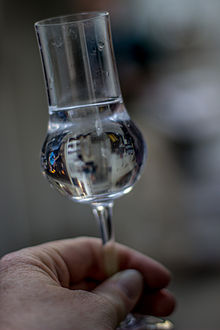Fruit brandy

Fruit brandy , Obstwasser or Obstler describes a spirit made from fruits such as pears, apples or plums. The fruits are mashed and subjected to alcoholic fermentation . A schnapps is obtained from this by distillation , one speaks of distillation . The minimum alcohol content is 37.5 percent by volume . The different types of fruit brandies are listed under spirit . In the case of Obstwasser / Obstbrand, the fruits used must be listed on the label in descending order (according to the quantity used), e.g. B. "Obstwasser made from apples and pears". A fruit brandy such as Mirabelle brandy / Mirabelle water, for example, is distilled from just one fruit, the eponymous fruit. No further fruits may be added. If the name contains a variety, as with Williams-Christ pear water, the fruit brandy must not contain any other varieties.
Manufacturing
The first step in the production of a fruit brandy is to mash the fruits that are needed for the respective brandy . For this purpose, the fruits are first crushed (often also pitted), then mixed with water and finally special fermentation yeast is added, which accelerates fermentation and ensures a higher alcohol concentration in the mash . Now, depending on the temperature, amount and type of mash , it is left to ferment for 3 days - 2 weeks . Following this, those will be in a still burned . The goal of the burn , as opposed to chemical distill , it is to maintain the flavors of the fruit. The almost finished brandy, which has an alcohol concentration of approx. 60–90%, is mixed with water, otherwise it would taste too hot, in order to achieve an alcohol content of the legally prescribed minimum 37.5 to 55 percent by volume . The spirits are then often stored in wooden barrels for up to 2 years in order to add additional aromas to the spirit.
Prohibited for manufacture
- additional flavoring
- additional sugar / alcohol
- Methanol quantities over 1000 g / hl, with a few exceptions
Used fruits
The quality of a fruit brandy depends largely on the quality of the fruit used to make it. The fruit should have reached the optimum level of consumption so that it has a distinctive aroma typical of the variety. The higher the sugar content, the greater the alcohol yield . To avoid brandy mistakes, the fruit must be free of soil, grass and leaves. Unripe, rotten, moldy and poorly formed fruits are not suitable. They contain little sugar and hardly any good aromatic substances.
All types of fruit are used such as:
- Apples , e.g. B. Rheinischer Bohnapfel , Rambour, Gravensteiner , Bittenfelder , all Renetten, Brettacher , Cox Orange , Kaiser Wilhelm , Trier wine apples
- Pears , e.g. B. Wine / Most pears , Gelbmöstler , Alexander Lucas , bottle pear , Conference , Williams Christ pear , Nelches pear
- Cherries
- plums
- Mirabelle plums
- Apricots
- Quinces
The average purchase price for fruit distilleries (in 2004) is around € 0.05 per kilogram for apples and around € 0.04 for pears. The fruit used often comes from orchards that are cultivated by many farms and part-time distillers. As a rule, the fruit of the orchards is not suitable as dessert fruit for immediate consumption. This so-called commercial fruit can, however, be used well for fruit juices, must , fruit brandy, jam and the production of agricultural alcohol .
The preservation, landscape and biotope maintenance of numerous orchards was achieved until December 31, 2017 (often only) through the purchase guarantee of the federal monopoly administration for spirits , which purchased the agricultural alcohol distilled by small farms and part-time distilleries at fixed liter prices.
Demarcation
- Fruit spirit
- In contrast to the fruit brandy, the fruit in the fruit spirit is only used to flavor pure, tasteless alcohol . Typically this happens with berry fruits whose low sugar content is insufficient for alcoholic fermentation. The raspberry spirit is best known under this form of spirit .
- Fruit pomace brandy
- Brandy made from the pomace of one or more types of fruit (except for grapes) is a fruit pomace brandy .
Storage and consumption temperature
Storage is not subject to any special requirements; it is usually enjoyed at room temperature or slightly chilled (sub-temperature).
See also
Web links
- Fruit schnapps . Entry no. 225 in the register of traditional foods of the Austrian Federal Ministry for Agriculture, Regions and Tourism .
Individual evidence
- ↑ a b Regulation (EC) No. 110/2008 of the European Parliament and of the Council of January 15, 2008 , Appendix II, 9th fruit brandy (see also: Spirits at www.was-wir-essen.de)
- ↑ Minimum alcohol content of spirits ( Memento of the original from October 22, 2012 in the Internet Archive ) Info: The archive link was inserted automatically and has not yet been checked. Please check the original and archive link according to the instructions and then remove this notice. - The federal authority of the Swiss Confederation
- ↑ The new liquor law. Retrieved March 22, 2020 .
- ↑ Burning (spirits) . In: Wikipedia . February 8, 2020 ( Special: Permanent Link / 196634204 [accessed on March 22, 2020]).
- ↑ The new liquor law. Retrieved March 22, 2020 .
